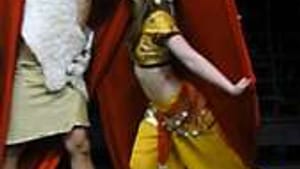Stay in the Loop
BSR publishes on a weekly schedule, with an email newsletter every Wednesday and Thursday morning. There’s no paywall, and subscribing is always free.
Does Salome still work?
Oscar Wilde's "Salome' at Villanova (2nd review)

I caught the final performance of Oscar Wilde's Salome at Villanova University's Vasey Theatre. Because the play— as opposed to the opera— is so rarely performed, it was an opportunity I couldn't pass up.
As an opera, I had always thought that Strauss's Salome, like Puccini's Tosca, is damn near foolproof. No dramaturge, however demented, can really wreck it.
(By contrast, when you stage Parsifal with the Knights of the Grail looking like a bunch of etiolated waitpersons in black slacks and white shirts, the drama looses a little something.)
The other draw to this production was that it laid to rest Lord Alfred Douglas's venerable 1893 translation of Wilde's French-language dramatic poem. (Yes, Wilde's Salome is a dramatic poem.) Instead the Villanova production used a translation by Joseph Donohue that promised to "unfreeze" the language. (In fairness to Douglas, I've always felt that his translation reads splendidly— it just doesn't act that well.)
Pity poor Herod
Donohue tries to steer a middle course, retaining some of the original version's overblown quality while making it a bit easier on the actors—although they still need prodigious memories to keep it all in place. Whatever poor fellow plays Herod (whom the play's first illustrator Aubrey Beardsley wisely deduced was a stand-in for Wilde) really needs to be on his toes.
So, cutting to the chase: Does Salome still hold up as a drama, without Strauss's thunderous score? In my opinion it does.
I went into the play not expecting much, frankly, and came away pleasantly surprised. The direction by the Reverend David Cregan—imagine, a priest directing Wilde!— was sharp and inventive, drawing out the most mileage possible from a fairly minimalist stage setting. The actors, most of whom are graduate students in the Villanova Theater program, were excellent, especially Seth Thomas Schmitt-Hall, working hard as Herod, and Lizzy Pecora, a splendidly acrobatic Salome who turned the famed Dance of the Seven Veils into an airborne extravaganza. I detected only one fluffed line in 90 minutes of non-stop declamation.
Janus Stefanowicz's costumes compensated for the minimalist stage settings and conjured up the sensuous atmosphere of Wilde's exotic Judea.
Major faux pas
Although I had occasional quibbles with Cregan's staging— I still think it's a major faux pas to have the prophet Iokanaan actually touch Salome, however briefly— on the whole I thought he brought the production off quite well. His use of Eastern chants was especially effective.
In the end, Salome the play still works. The action is brief enough, and the build-up of tension is steady enough to render Wilde's poem truly a dramatic one.♦
To read another review by Steve Cohen, click here.
As an opera, I had always thought that Strauss's Salome, like Puccini's Tosca, is damn near foolproof. No dramaturge, however demented, can really wreck it.
(By contrast, when you stage Parsifal with the Knights of the Grail looking like a bunch of etiolated waitpersons in black slacks and white shirts, the drama looses a little something.)
The other draw to this production was that it laid to rest Lord Alfred Douglas's venerable 1893 translation of Wilde's French-language dramatic poem. (Yes, Wilde's Salome is a dramatic poem.) Instead the Villanova production used a translation by Joseph Donohue that promised to "unfreeze" the language. (In fairness to Douglas, I've always felt that his translation reads splendidly— it just doesn't act that well.)
Pity poor Herod
Donohue tries to steer a middle course, retaining some of the original version's overblown quality while making it a bit easier on the actors—although they still need prodigious memories to keep it all in place. Whatever poor fellow plays Herod (whom the play's first illustrator Aubrey Beardsley wisely deduced was a stand-in for Wilde) really needs to be on his toes.
So, cutting to the chase: Does Salome still hold up as a drama, without Strauss's thunderous score? In my opinion it does.
I went into the play not expecting much, frankly, and came away pleasantly surprised. The direction by the Reverend David Cregan—imagine, a priest directing Wilde!— was sharp and inventive, drawing out the most mileage possible from a fairly minimalist stage setting. The actors, most of whom are graduate students in the Villanova Theater program, were excellent, especially Seth Thomas Schmitt-Hall, working hard as Herod, and Lizzy Pecora, a splendidly acrobatic Salome who turned the famed Dance of the Seven Veils into an airborne extravaganza. I detected only one fluffed line in 90 minutes of non-stop declamation.
Janus Stefanowicz's costumes compensated for the minimalist stage settings and conjured up the sensuous atmosphere of Wilde's exotic Judea.
Major faux pas
Although I had occasional quibbles with Cregan's staging— I still think it's a major faux pas to have the prophet Iokanaan actually touch Salome, however briefly— on the whole I thought he brought the production off quite well. His use of Eastern chants was especially effective.
In the end, Salome the play still works. The action is brief enough, and the build-up of tension is steady enough to render Wilde's poem truly a dramatic one.♦
To read another review by Steve Cohen, click here.
What, When, Where
Salome. By Oscar Wilde. Premiere of a new translation by Joseph Donohue; David Cregan directed. Through April 21, 2013 at Villanova Theatre, Vasey Hall, 800 E. Lancaster Avenue, Villanova, Pa. (610) 519-4500 or www.theatre.villanova.edu.
Sign up for our newsletter
All of the week's new articles, all in one place. Sign up for the free weekly BSR newsletters, and don't miss a conversation.